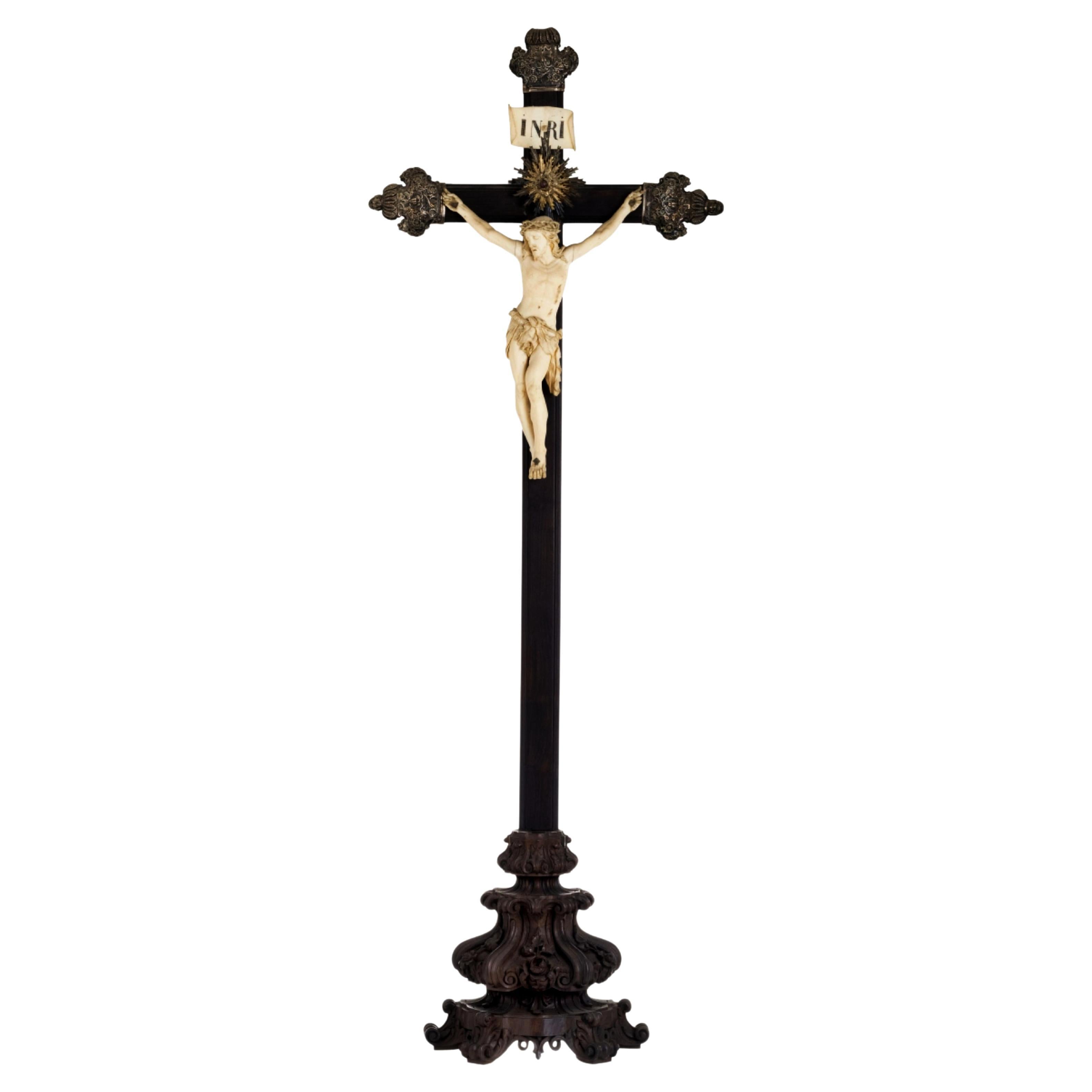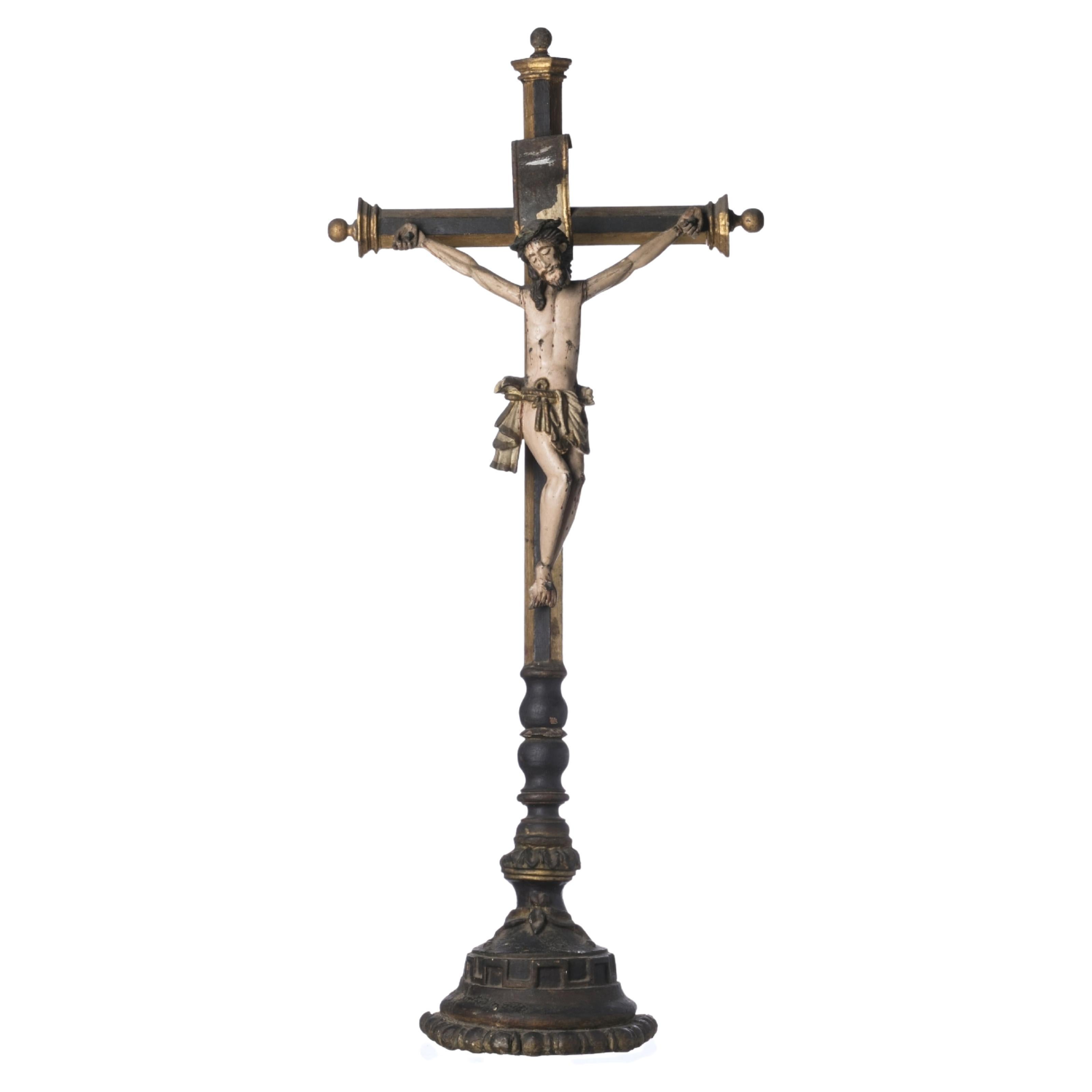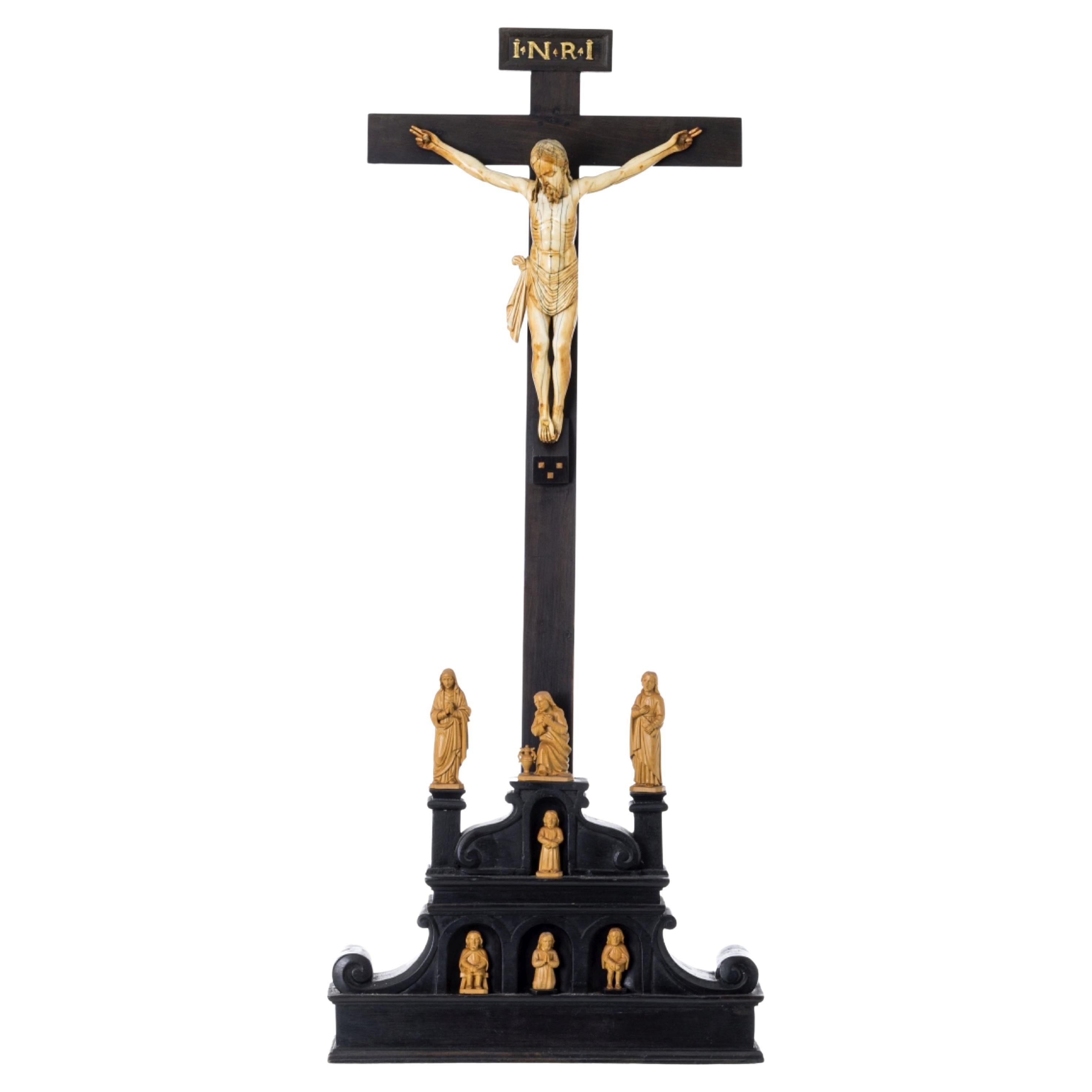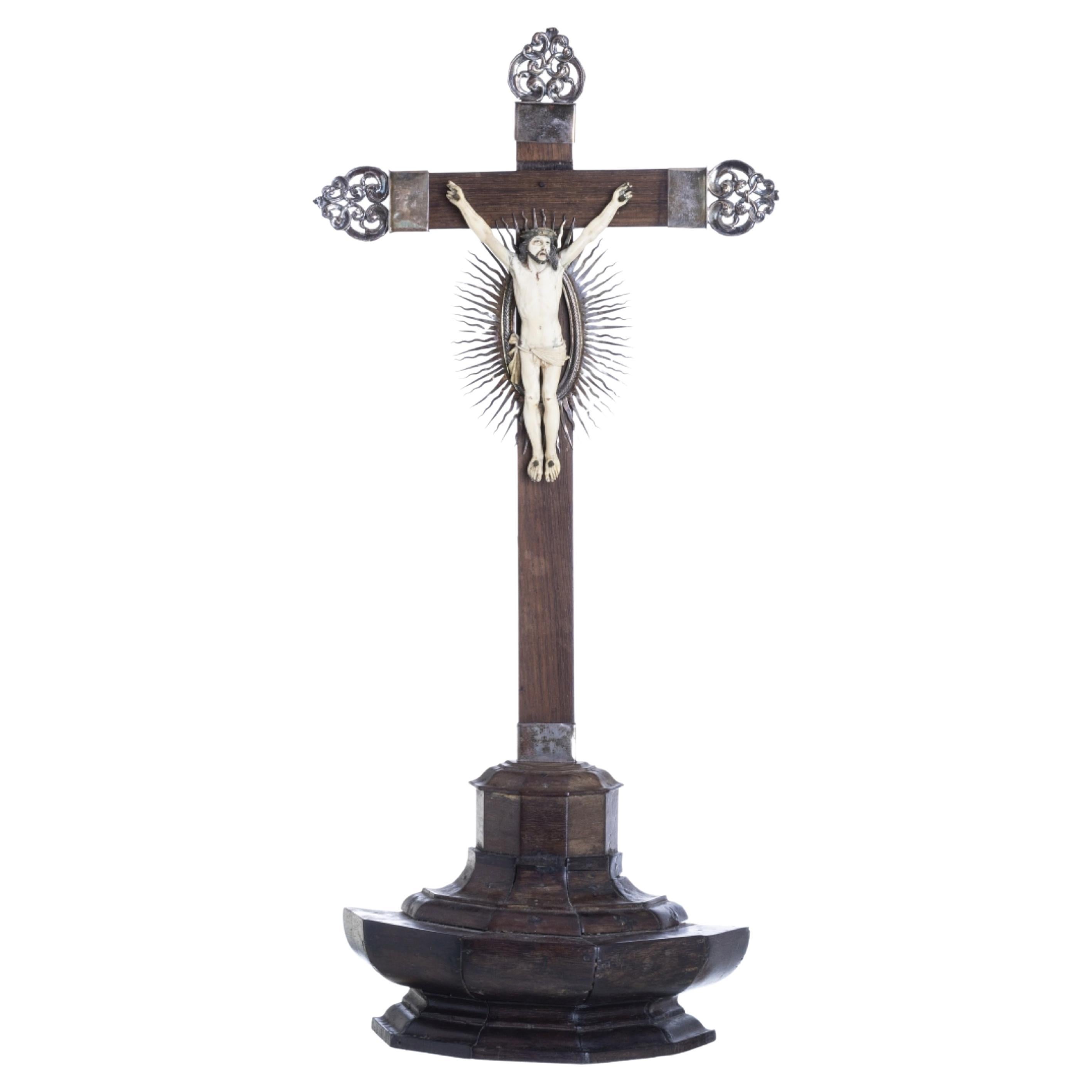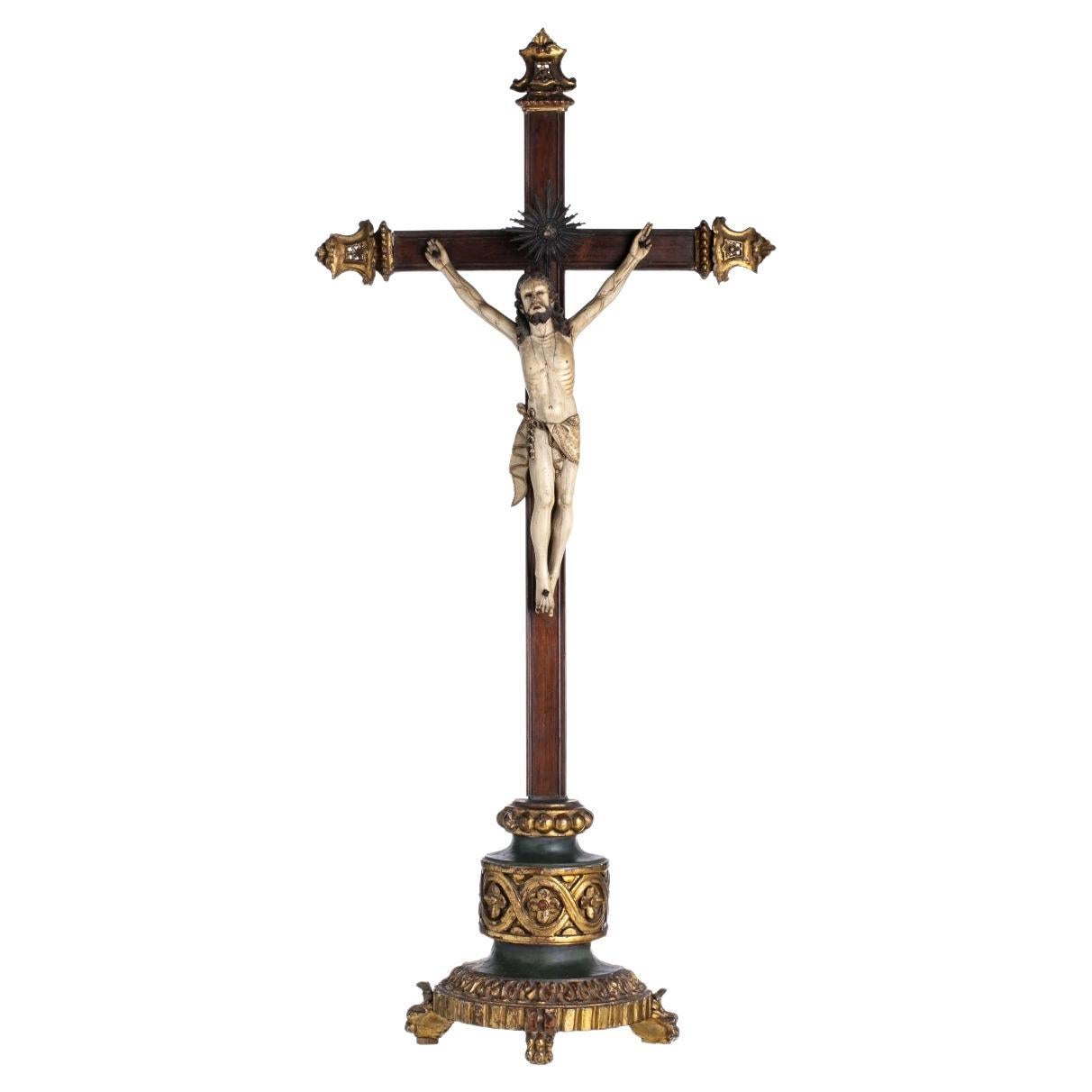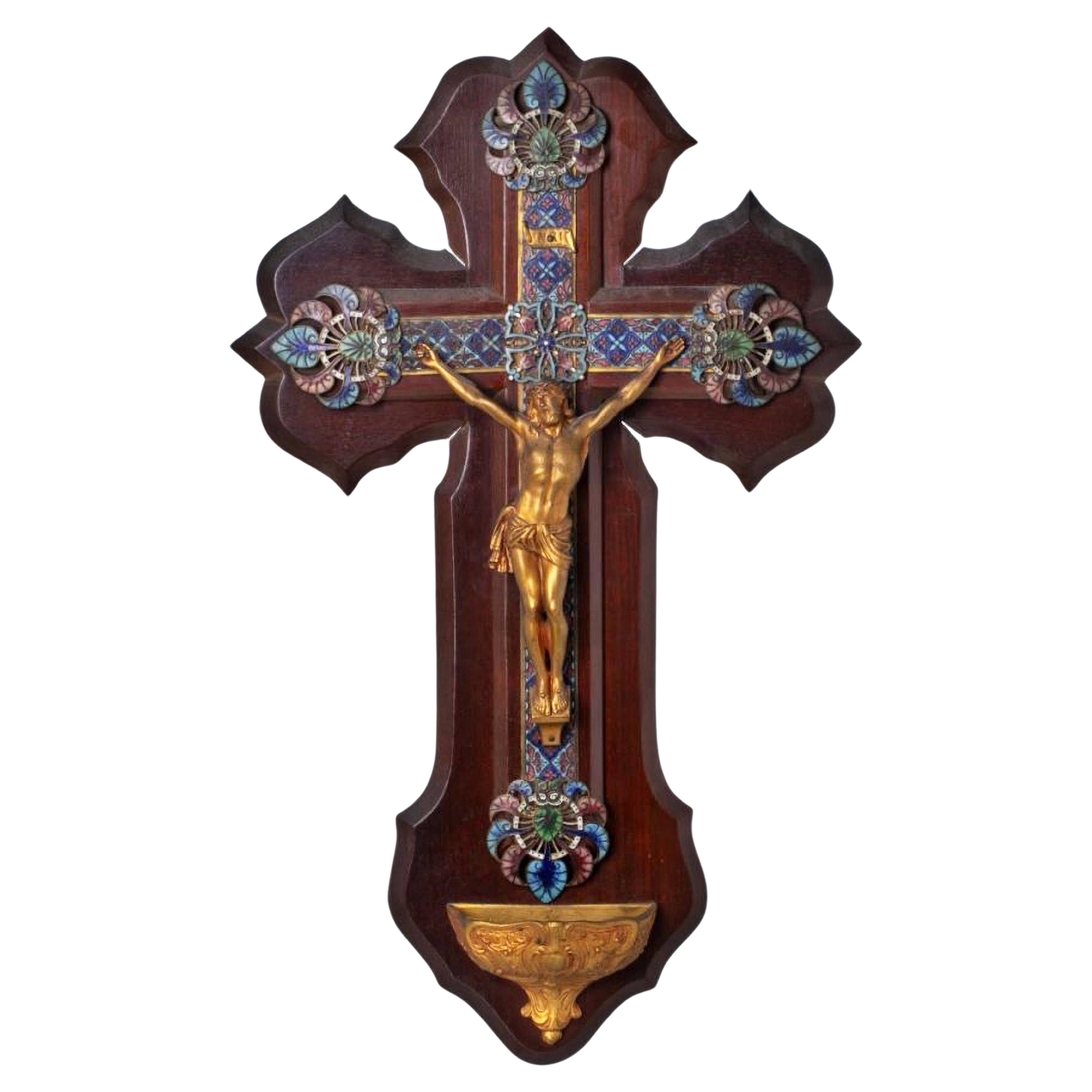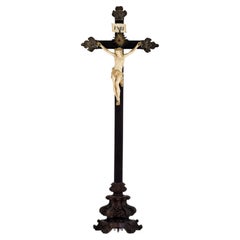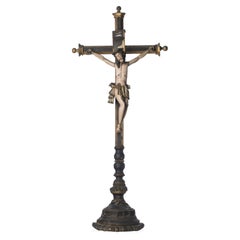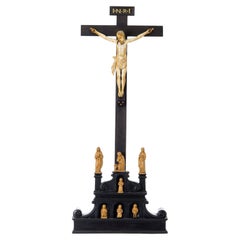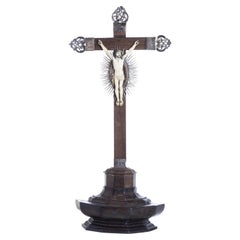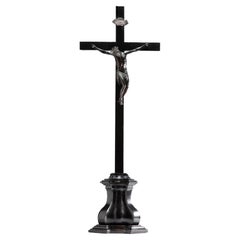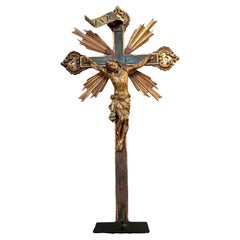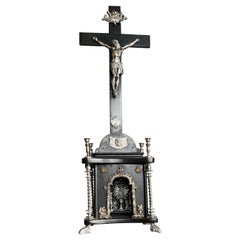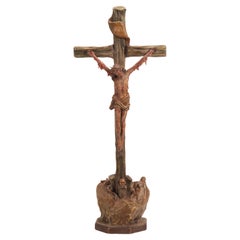Items Similar to Large Cross with Christ from the 18th Century
Want more images or videos?
Request additional images or videos from the seller
1 of 10
Large Cross with Christ from the 18th Century
$2,924.82
£2,155.58
€2,450
CA$4,003.43
A$4,484.06
CHF 2,333.20
MX$54,458.56
NOK 29,579.10
SEK 27,910.08
DKK 18,646.10
Shipping
Retrieving quote...The 1stDibs Promise:
Authenticity Guarantee,
Money-Back Guarantee,
24-Hour Cancellation
About the Item
Large cross with christ from the 18th century. The cross is decorated with tortoise shell, ivory and ebony. The christ is sculpted in high quality ivory. Very good general condition, measurements: 94x37x14cm.
Good condition,
- Dimensions:Height: 37.01 in (94 cm)Width: 14.57 in (37 cm)Depth: 5.52 in (14 cm)
- Style:Baroque (Of the Period)
- Materials and Techniques:
- Place of Origin:
- Period:
- Date of Manufacture:18th Century
- Condition:Wear consistent with age and use.
- Seller Location:Madrid, ES
- Reference Number:1stDibs: LU5779230162482
About the Seller
4.8
Platinum Seller
Premium sellers with a 4.7+ rating and 24-hour response times
Established in 2005
1stDibs seller since 2021
360 sales on 1stDibs
Typical response time: 1 hour
- ShippingRetrieving quote...Shipping from: Madrid, Spain
- Return Policy
Authenticity Guarantee
In the unlikely event there’s an issue with an item’s authenticity, contact us within 1 year for a full refund. DetailsMoney-Back Guarantee
If your item is not as described, is damaged in transit, or does not arrive, contact us within 7 days for a full refund. Details24-Hour Cancellation
You have a 24-hour grace period in which to reconsider your purchase, with no questions asked.Vetted Professional Sellers
Our world-class sellers must adhere to strict standards for service and quality, maintaining the integrity of our listings.Price-Match Guarantee
If you find that a seller listed the same item for a lower price elsewhere, we’ll match it.Trusted Global Delivery
Our best-in-class carrier network provides specialized shipping options worldwide, including custom delivery.More From This Seller
View AllJESUS CHRIST CRUCIFIED 18th Century Italian Sculpture
Located in Madrid, ES
JESUS CHRIST CRUCIFIED 18th Century
Italian Sculpture
in ivor.... The figure is represented dead, wearing a cendal point at the waist. Cross in carved rosewood wood. Silver termin...
Category
Antique Early 18th Century Italian Baroque Religious Items
Materials
Wood
JESUS CHRIST CRUCIFIED Portuguese Sculpture from the 17th Century
Located in Madrid, ES
JESUS CHRIST CRUCIFIED
17th Century Portuguese sculpture
in carved wood, polychrome and gilded.
Small flaws in the polychromy.
Height: (Christ) 32 cm. Height: (total) 86 cm.
good co...
Category
Antique 17th Century Portuguese Baroque Religious Items
Materials
Wood
JESUS CHRIST CRUCIFIED Indo-Portuguese Sculpture from the 17th Century
Located in Madrid, ES
JESUS CHRIST CRUCIFIED
Sinhalese-Portuguese sculpture, from the 17th century
in ivor... The figure is represented dead wearing cendal draped around the waist. With cross in exotic w...
Category
Antique 17th Century Portuguese Baroque Religious Items
Materials
Wood
JESUS CHRIST CRUCIFIED Indo-Portuguese sculpture from the 17th Century
Located in Madrid, ES
JESUS CHRIST CRUCIFIED
Indo-Portuguese sculpture from the 17th century
in ivor... The figure is represented dead, wearing a cendal point at the waist. Cross in carved rosewood wood....
Category
Antique 17th Century Portuguese Baroque Religious Items
Materials
Wood
JESUS CHRIST CRUCIFIED Indo-Portuguese sculpture from the 18th Century
Located in Madrid, ES
JESUS CHRIST CRUCIFIED
Indo-Portuguese sculpture from the 18th Century
in ivor..... The figure is represented in agony, with cendal draped around the waist. Cross in rosewood wood ...
Category
Antique Early 18th Century Portuguese Baroque Religious Items
Materials
Wood
JESUS CHRIST CRUCIFIED European, 19th century
Located in Madrid, ES
JESUS CHRIST CRUCIFIED
European, Germany ? 19th century
Christ and font in bronze, wooden cross, covered with enamel.
Slight wear.
Dim.: (cross) 50 x 30 cm;
Height: (christ) 16 cm...
Category
Antique 19th Century German Baroque Figurative Sculptures
Materials
Bronze
You May Also Like
Crucifix, Bronze, iron, and wood, Lombardy, mid-17th century
Located in Milano, IT
Crucifix
Lombardy, mid-17th century
Bronze, iron, and wood
Sculpture: 33 cm height x 35 cm width x 10 cm depth at the knees;
Cross: 42.12 in height x 19.68 in width (107 cm x 50);
Ba...
Category
Antique Mid-17th Century Italian Baroque Figurative Sculptures
Materials
Bronze, Iron
17th Century Carved Wood and Polychromed of Crucified Jesus on the Cross
Located in North Miami, FL
Introducing a captivating 17th-century Italian carved wood and polychromed, gold-gilded crucifix depicting Jesus on the cross. This remarkable piece...
Category
Antique 17th Century Italian Baroque Figurative Sculptures
Materials
Metal
$11,165 Sale Price
30% Off
Antique Altar Crucifix Detailed Silvered Bronze Sculpture of Christ & Monstrance
Located in Lisse, NL
Unique table crucifix and a wonderful work of religious art.
For us the most powerful statement will always be 'the truth will set you free'. It is what we have learned most from th...
Category
Antique Mid-19th Century European Gothic Revival Religious Items
Materials
Silver, Bronze
Crucifix on Calvary, Called Plague of Christ, France, Early 18th Century
Located in Milan, IT
Crucifix on Calvary, called 'Pestis Christi' or Crucifiix Pestis 'Plague of Christ' or Plague Crucifix). The sculpture is composite, made with heterogeneous materials: wax, wood, papier-mâché. The octagonal base is slightly raised and supports the calvary, symbolized by rocks, from which the crucifix rises, made with intentionally unfinished boards and with marked veins. The depicted Christ is peculiar: he shows scarified skin all over his body. Masterfully crafted in wax. They are the plagues of the plague that Christ, 'Agnus Dei' takes charge of with salvific value, for the salvation of the world. At his feet the ordeal full of symbols: evil (snake) with the apple, the 'Memento mori' of human bones...
Category
Antique Early 18th Century French Religious Items
Materials
Wood, Paper
Stunning & Powerful Altar Crucifix with Detailed Bronze Sculpture of Christ 1912
Located in Lisse, NL
Unique table crucifix and a wonderful work of religious art, dated 1912 and numbered.
For us the most powerful statement will always be 'the truth will set you free'. It is what we have learned most from the life of Christ and of His teachings and it is the one thing we always think about whenever we look at a crucifix. Anyone who has tried to break down his/her ego and found a clearer consciousness in the process knows how healing and rewarding that journey can be. After that you can only be grateful for all the good things that are bound to come your way. Good things will come your way, because the universe needs people like you. Whomever created this amazing work of religious art too must have been inspired and motivated by the life of Christ, because how ever could anyone create a piece that is of such quality, so beautiful and so powerful at the same time. Both the beautifully designed bronze cross with the King of the Jews inscription and the amazingly detailed bronze corpus of Christ are of a quality that you will only rarely find on the open market. They are perfectly mounted on a stunning marble base and together they create one of the most impressive table or altar crucifixes...
Category
Early 20th Century European Gothic Revival Religious Items
Materials
Marble, Bronze
Rare and important painted bronze Crucifix after a model by Michelangelo
By Michelangelo Buonarroti
Located in Leesburg, VA
A rare and very fine bronze corpus of Christ after a model by Michelangelo, cast ca. 1597-1600 by Juan Bautista Franconio and painted in 1600 by Francisco Pacheco in Seville, Spain.
The present corpus reproduces a model attributed to Michelangelo. The best known example, lesser in quality, is one on display at the Metropolitan Museum of Art (MET).
The association of this corpus with Michelangelo was first brought to light by Manuel Gomez-Moreno (1930-33) who studied the wider circulated casts identified throughout Spain. The attribution to Michelangelo was subsequently followed by John Goldsmith-Phillips (1937) of the MET and again by Michelangelo expert, Charles de Tolnay (1960).
While Michelangelo is best known for his monumental works, there are four documented crucifixes he made. The best known example is the large-scale wooden crucifix for the Church of Santa Maria del Santo Spirito in Florence, made in 1492 as a gift for the Prior, Giovanni di Lap Bicchiellini, for allowing him to study the anatomy of corpses at the hospital there. In 1562, Michelangelo wrote two letters to his nephew, Lionardo, indicating his intention to carve a wooden crucifix for him. In 1563 a letter between Lionardo and the Italian sculptor Tiberio Calcagni, mentions this same crucifix (a sketch of a corpus on the verso of a sheet depicting Michelangelo’s designs for St. Peter’s Basillica [Palais des Beaux-Arts in Lille] may reproduce this). That Michelangelo was working on small corpora in the last years of his life is further evidenced by the small (26.5 cm) unfinished wooden crucifix located at the Casa Buonarroti, considered his last known sculptural undertaking. Michelangelo’s contemporary biographer, Giorgio Vasari additionally cites that Michelangelo, in his later years, made a small crucifix for his friend, Menighella, as a gift.
Surviving sketches also indicate Michelangelo’s study of this subject throughout his career, most notably during the end of his life but also during the 1530s-40s as he deepened his spiritual roots. The occasional cameo of crucified Christ’s throughout his sketched oeuvre have made it challenging for scholars to link such sketches to any documented commissions of importance. All the while, in consideration that such objects were made as gifts, it is unlikely they should be linked with commissions.
Nonetheless, a number of theories concerning Michelangelo’s sketches of Christ crucified have been proposed and some may regard the origin of the present sculpture. It has been suggested that the corpus could have its impetus with Michelangelo’s work on the Medici Chapel, whose exclusive design was given to the master. It is sensible smaller details, like an altar cross, could have fallen under his responsibility (see for example British Museum, Inv. 1859,0625.552). Others have noted the possibility of an unrealized large marble Crucifixion group which never came to fruition but whose marble blocks had been measured according to a sheet at the Casa Buonarroti.
A unique suggestion is that Michelangelo could have made the crucifix for Vittoria Colonna, of whom he was exceedingly fond and with whom he exchanged gifts along with mutual spiritual proclivities. In particular, Vittoria had an interest in the life of St. Bridget, whose vision of Christ closely resembles our sculpture, most notably with Christ’s proper-left leg and foot crossed over his right, an iconography that is incredibly scarce for crucifixes. The suggestion could add sense to Benedetto Varchi’s comment that Michelangelo made a sculpted “nude Christ…he gave to the most divine Marchesa of Pescara (Vittoria Colonna).”
Of that same period, two sketches can be visually linked to our sculpture. Tolnay relates it to a sketch of a Crucified Christ at the Teylers Museum (Inv. A034) of which Paul Joannides comments on its quality as suggestive of preparations for a sculptural work. Joannides also calls attention to a related drawing attributed to Raffaello da Montelupo copying what is believed to be a lost sketch by Michelangelo. Its relationship with our sculpture is apparent. Montelupo, a pupil of Michelangelo’s, returned to Rome to serve him in 1541, assisting with the continued work on the tomb of Pope Julius II, suggesting again an origin for the corpus ca. 1540.
The earliest firm date that can be given to the present corpus is 1574 where it appears as a rather crudely conceived Crucifixion panel, flanked by two mourners in low-relief and integrally cast for use as the bronze tabernacle door to a ciborium now located at the Church of San Lorenzo in Padula. Etched in wax residue on the back of the door is the date, 27 January 1574, indicating the corpus would have at least been available as a model by late 1573.
The Padula tabernacle was completed by Michelangelo’s assistant, Jacopo del Duca and likely has its origins with Michelangelo’s uncompleted tabernacle for the Basilica of St. Mary of the Angels in Rome.
The impetus for the Padula tabernacle’s Crucifixion panel begins with a series of late Crucifixion sketches by Michelangelo, depicting a scene of Christ crucified and flanked by two mourners (see British Museum Inv. 1895.0915.510; Ashmolean Museum Inv. 1846.89, KP II 343 recto; Windsor Castle RCIN 912761 recto; and Louvre Inv. 700). A faintly traced block possibly intended for sculpting the sketch of the crucified Christ on its recto was discovered by Tolnay on a version of the composition at Windsor Castle. The Windsor sketch and those related to it appear to have served as preparatory designs for what was probably intended to become the Basilica of St. Mary’s tabernacle door. Vasari documents that the project was to be designed by Michelangelo and cast by his assistant, Jacopo del Duca. Michelangelo died before the commission was complete, though on 15 March 1565, Jacopo writes to Michelangelo’s nephew stating, “I have started making the bronze tabernacle, depending on the model of his that was in Rome, already almost half complete.” Various circumstances interrupted the completion of the tabernacle, though its concept is later revitalized by Jacopo during preparations to sell a tabernacle, after Michelangelo’s designs, to Spain for Madrid’s El Escorial almost a decade later. The El Escorial tabernacle likewise encountered problems and was aborted but Jacopo successfully sold it shortly thereafter to the Carthusians of Padula.
An etched date, 30 May 1572, along the base of the Padula tabernacle indicates its framework was already cast by then. A 1573 summary of the tabernacle also describes the original format for the door and relief panels, intended to be square in dimension. However, a last minute decision to heighten them was abruptly made during Jacopo’s negotiations to sell the tabernacle to King Phillip II of Spain. Shortly thereafter the commission was aborted. Philippe Malgouyres notes that the Padula tabernacle’s final state is a mixed product of the original design intended for Spain’s El Escorial, recycling various parts that had already been cast and adding new quickly finished elements for its sale to Padula, explaining its unusually discordant quality, particularly as concerns the crudeness of the door and relief panels which were clearly made later (by January 1574).
Apart from his own admission in letters to Spain, it is apparent, however, that Jacopo relied upon his deceased master’s designs while hastily realizing the Padula panels. If Michelangelo had already earlier conceived a crucifix model, and Jacopo had access to that model, its logical he could have hastily employed it for incorporation on the door panel to the tabernacle. It is worth noting some modifications he made to the model, extending Christ’s arms further up in order to fit them into the scale of the panel and further lowering his chin to his chest in order to instill physiognomic congruence. A crude panel of the Deposition also follows after Michelangelo’s late sketches and is likewise known by examples thought to be modifications by Jacopo based upon Michelangelo’s initial sculptural conception (see Malgouyres: La Deposition du Christ de Jacopo del Duca, chef-d’oeuvre posthume de Michel-Ange).
Jacopo’s appropriation of an original model by Michelangelo for more than one relief on the Padula tabernacle adds further indication that the crucifix was not an object unique to Jacopo’s hand, as few scholars have posited, but rather belongs to Michelangelo’s original...
Category
Antique 16th Century Renaissance Figurative Sculptures
Materials
Bronze
More Ways To Browse
Large Cross
Antique Wood Cross
Christ Cross
Baroque Cross
Antique Wood Christ
Ivory Cross
Crosses With Christ
Ivory Christ
Cherubs From Italy
Male Torso
Bronze Cherub Sculpture
Monumental Statue
Art Deco Female Bronze Sculptures
Carved Stone Relief
Bronze Hermes
Grape Stand
Metal Ship Sculpture
Societe Des Bronzes De Paris
